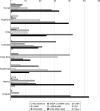Respiratory medication used in COPD patients from seven Latin American countries: the LASSYC study
- PMID: 29785104
- PMCID: PMC5955011
- DOI: 10.2147/COPD.S154097
Respiratory medication used in COPD patients from seven Latin American countries: the LASSYC study
Erratum in
-
Erratum: Respiratory medication used in COPD patients from seven Latin American countries: the LASSYC study [Corrigendum].Int J Chron Obstruct Pulmon Dis. 2019 Jan 18;14:241. doi: 10.2147/COPD.S194429. eCollection 2019. Int J Chron Obstruct Pulmon Dis. 2019. PMID: 30718948 Free PMC article.
Abstract
Background: Limited information is available regarding medication use in COPD patients from Latin America. This study evaluated the type of medication used and the adherence to different inhaled treatments in stable COPD patients from the Latin American region.
Methods: This was an observational, cross-sectional, multinational, and multicenter study in COPD patients attended by specialist doctors from seven Latin American countries. Adherence to inhaled therapy was assessed using the Test of Adherence to Inhalers (TAI) questionnaire. The type of medication was assessed as: short-acting β-agonist (SABA) or short-acting muscarinic antagonist (SAMA) only, long-acting muscarinic antagonist (LAMA), long-acting β-agonist (LABA), LABA/LAMA, inhaled corticosteroid (ICS), ICS/LABA, ICS/LAMA/LABA, or other.
Results: In total, 795 patients were included (59.6% male), with a mean age of 69.5±8.7 years and post-bronchodilator FEV1 of 50.0%±18.6%. The ICS/LAMA/LABA (32.9%) and ICS/LABA (27.7%) combinations were the most common medications used, followed by LABA/LAMA (11.3%), SABA or SAMA (7.9%), LABA (6.4%), LAMA (5.8%), and ICS (4.3%). The types of medication most commonly used in each Global Initiative for Chronic Obstructive Lung Disease (GOLD) 2013 category were ICS/LABA (A: 32.7%; B: 19.8%; C: 25.7%; D: 28.2%) and ICS/LAMA/LABA (A: 17.3%; B: 30.2%; C: 33%; D: 41.1%). The use of long-acting bronchodilators showed the highest adherence (good or high adherence >50%) according to the TAI questionnaire.
Conclusion: COPD management in specialist practice in Latin America does not follow the current guideline recommendations and there is an overuse of ICSs in patients with COPD from this region. Treatment regimens including the use of long-acting bronchodilators are associated with the highest adherence.
Keywords: COPD; Latin America; adherence; inhaled therapy.
Conflict of interest statement
Disclosure AM has been paid for her work as a statistician for the LASSYC study. LR is an employee of AstraZeneca. The other authors report no conflicts of interest in this work.
Figures



References
-
- Vogelmeier CF, Criner GJ, Martinez FJ, et al. Global Strategy for the Diagnosis, Management, and Prevention of Chronic Obstructive Lung Disease 2017 Report. GOLD Executive Summary. Am J Respir Crit Care Med. 2017;195(5):557–582. - PubMed
-
- Montes de Oca M, López Varela MV, Laucho-Contreras ME, et al. Classification of patients with chronic obstructive pulmonary disease according to the Latin American Thoracic Association (ALAT) staging systems and the global initiative for chronic obstructive pulmonary disease (GOLD) Arch Bronconeumol. 2017;53(3):98–106. - PubMed
-
- Miravitlles M, Soler-Cataluña JJ, Calle M, et al. Spanish COPD guidelines (GesEPOC) 2017 Pharmacological treatment of stable chronic obstructive pulmonary disease. Arch Bronconeumol. 2017;53(6):324–335. - PubMed
Publication types
MeSH terms
Substances
LinkOut - more resources
Full Text Sources
Other Literature Sources
Medical

